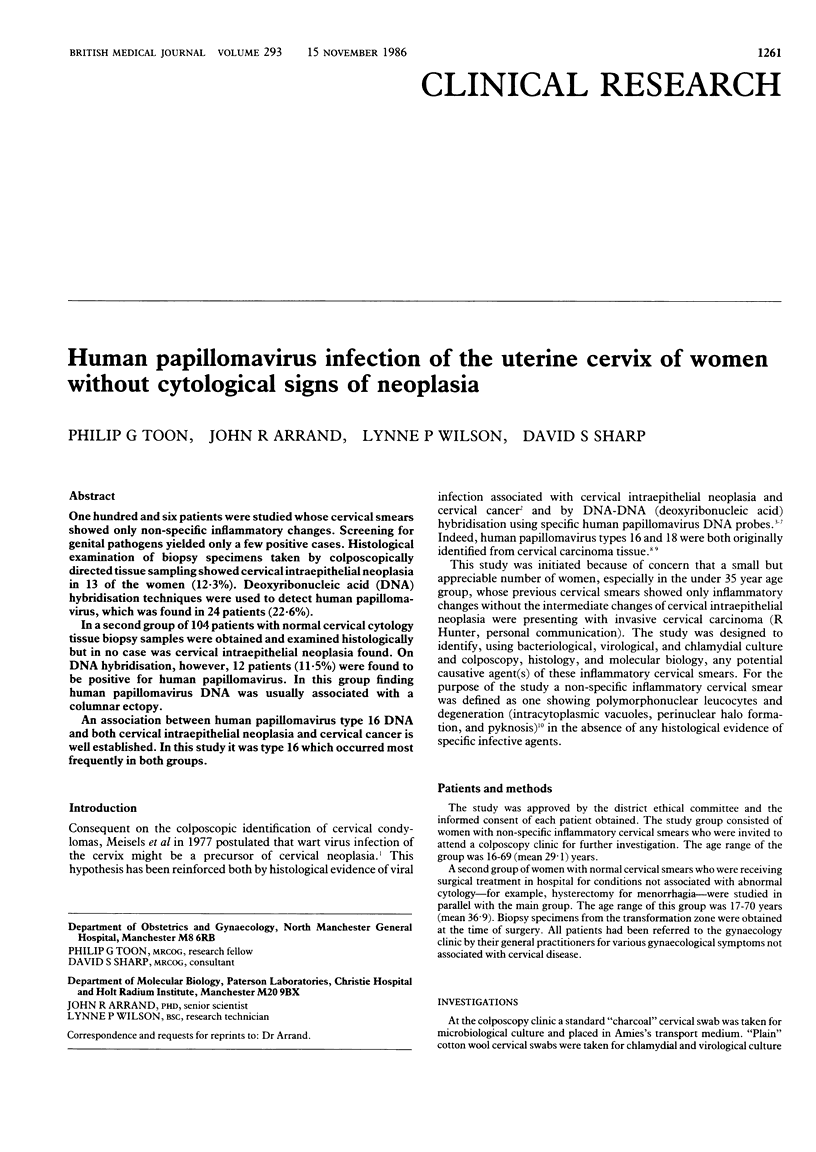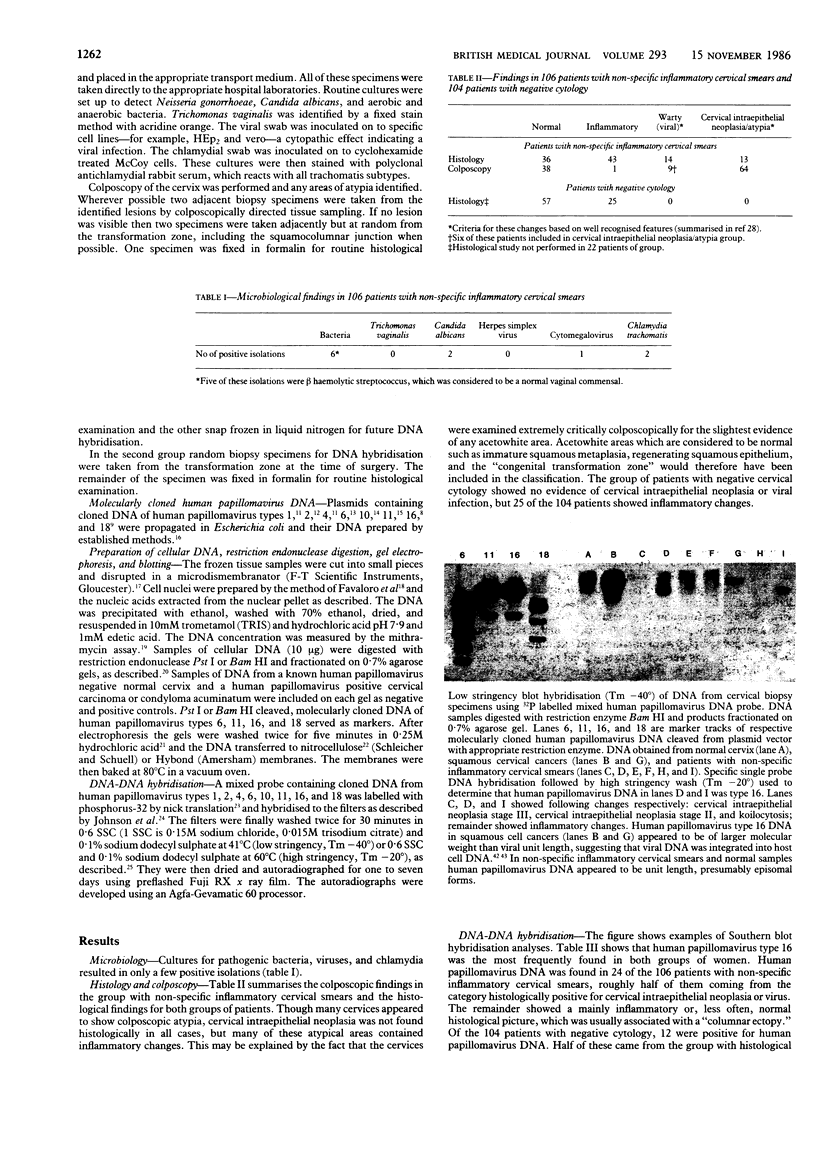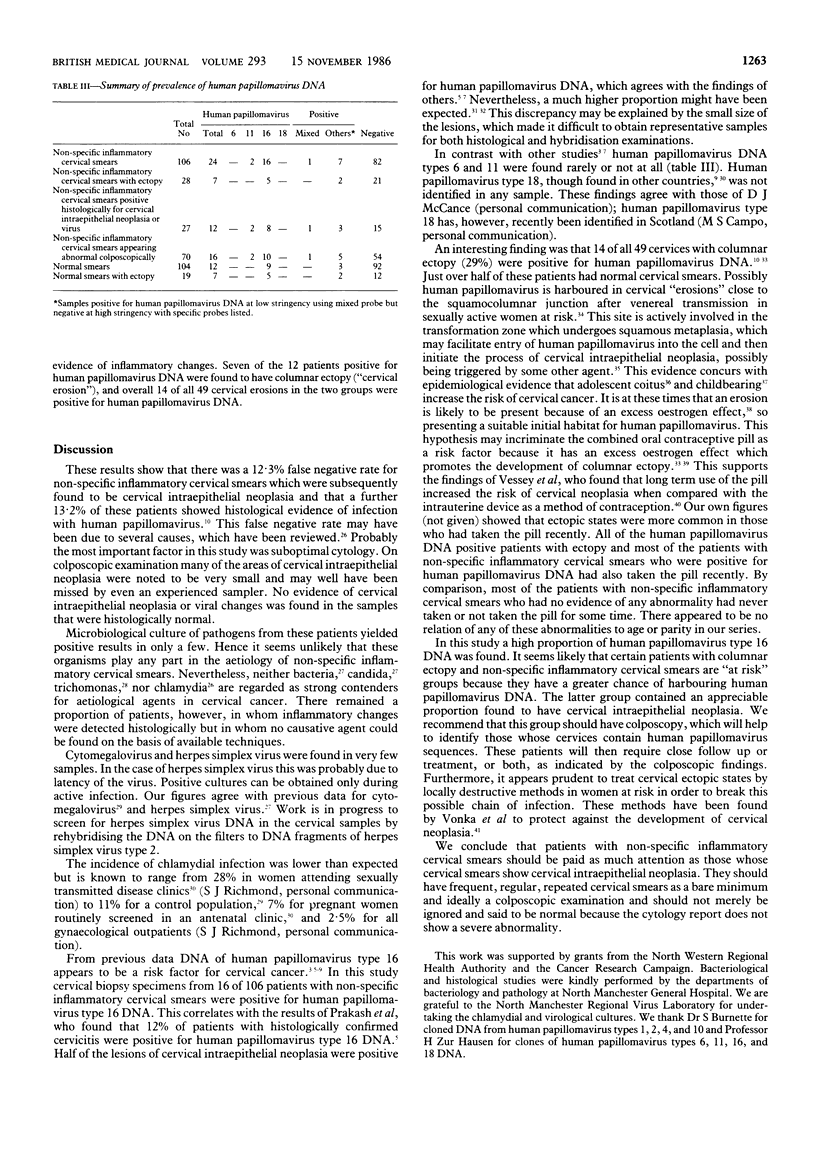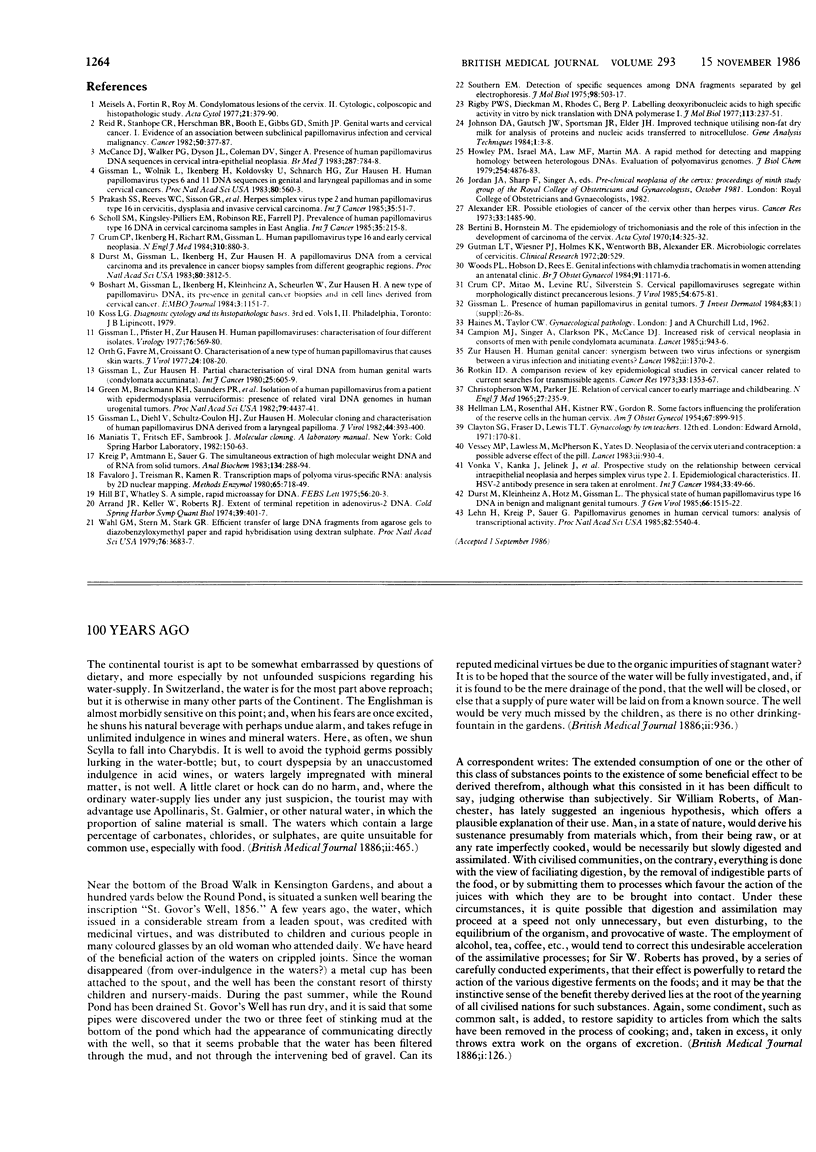Abstract
One hundred and six patients were studied whose cervical smears showed only non-specific inflammatory changes. Screening for genital pathogens yielded only a few positive cases. Histological examination of biopsy specimens taken by colposcopically directed tissue sampling showed cervical intraepithelial neoplasia in 13 of the women (12.3%). Deoxyribonucleic acid (DNA) hybridisation techniques were used to detect human papillomavirus, which was found in 24 patients (22.6%). In a second group of 104 patients with normal cervical cytology tissue biopsy samples were obtained and examined histologically but in no case was cervical intraepithelial neoplasia found. On DNA hybridisation, however, 12 patients (11.5%) were found to be positive for human papillomavirus. In this group finding human papillomavirus DNA was usually associated with a columnar ectopy. An association between human papillomavirus type 16 DNA and both cervical intraepithelial neoplasia and cervical cancer is well established. In this study it was type 16 which occurred most frequently in both groups.
Full text
PDF



Images in this article
Selected References
These references are in PubMed. This may not be the complete list of references from this article.
- Alexander E. R. Possible etiologies of cancer of the cervix other than herpesvirus. Cancer Res. 1973 Jun;33(6):1485–1490. [PubMed] [Google Scholar]
- Arrand J. R., Keller W., Roberts R. J. Extent of terminal repetition in adenovirus 2 DNA. Cold Spring Harb Symp Quant Biol. 1975;39(Pt 1):401–407. doi: 10.1101/sqb.1974.039.01.052. [DOI] [PubMed] [Google Scholar]
- Bertini B., Hornstein M. The epidemiology of trichomoniasis and the role of this infection in the development of carcinoma of the cervix. Acta Cytol. 1970 May;14(5):325–332. [PubMed] [Google Scholar]
- Campion M. J., Singer A., Clarkson P. K., McCance D. J. Increased risk of cervical neoplasia in consorts of men with penile condylomata acuminata. Lancet. 1985 Apr 27;1(8435):943–946. doi: 10.1016/s0140-6736(85)91724-6. [DOI] [PubMed] [Google Scholar]
- Crum C. P., Mitao M., Levine R. U., Silverstein S. Cervical papillomaviruses segregate within morphologically distinct precancerous lesions. J Virol. 1985 Jun;54(3):675–681. doi: 10.1128/jvi.54.3.675-681.1985. [DOI] [PMC free article] [PubMed] [Google Scholar]
- Dürst M., Gissmann L., Ikenberg H., zur Hausen H. A papillomavirus DNA from a cervical carcinoma and its prevalence in cancer biopsy samples from different geographic regions. Proc Natl Acad Sci U S A. 1983 Jun;80(12):3812–3815. doi: 10.1073/pnas.80.12.3812. [DOI] [PMC free article] [PubMed] [Google Scholar]
- Dürst M., Kleinheinz A., Hotz M., Gissmann L. The physical state of human papillomavirus type 16 DNA in benign and malignant genital tumours. J Gen Virol. 1985 Jul;66(Pt 7):1515–1522. doi: 10.1099/0022-1317-66-7-1515. [DOI] [PubMed] [Google Scholar]
- Gissmann L., Diehl V., Schultz-Coulon H. J., zur Hausen H. Molecular cloning and characterization of human papilloma virus DNA derived from a laryngeal papilloma. J Virol. 1982 Oct;44(1):393–400. doi: 10.1128/jvi.44.1.393-400.1982. [DOI] [PMC free article] [PubMed] [Google Scholar]
- Gissmann L., Pfister H., Zur Hausen H. Human papilloma viruses (HPV): characterization of four different isolates. Virology. 1977 Feb;76(2):569–580. doi: 10.1016/0042-6822(77)90239-2. [DOI] [PubMed] [Google Scholar]
- Gissmann L., Wolnik L., Ikenberg H., Koldovsky U., Schnürch H. G., zur Hausen H. Human papillomavirus types 6 and 11 DNA sequences in genital and laryngeal papillomas and in some cervical cancers. Proc Natl Acad Sci U S A. 1983 Jan;80(2):560–563. doi: 10.1073/pnas.80.2.560. [DOI] [PMC free article] [PubMed] [Google Scholar]
- Gissmann L., zur Hausen H. Partial characterization of viral DNA from human genital warts (Condylomata acuminata). Int J Cancer. 1980 May 15;25(5):605–609. doi: 10.1002/ijc.2910250509. [DOI] [PubMed] [Google Scholar]
- Green M., Brackmann K. H., Sanders P. R., Loewenstein P. M., Freel J. H., Eisinger M., Switlyk S. A. Isolation of a human papillomavirus from a patient with epidermodysplasia verruciformis: presence of related viral DNA genomes in human urogenital tumors. Proc Natl Acad Sci U S A. 1982 Jul;79(14):4437–4441. doi: 10.1073/pnas.79.14.4437. [DOI] [PMC free article] [PubMed] [Google Scholar]
- HELLMAN L. M., ROSENTHAL A. H., KISTNER R. W., GORDON R. Some factors influencing the proliferation of the reserve cells in the human cervix. Am J Obstet Gynecol. 1954 Apr;67(4):899–915. doi: 10.1016/0002-9378(54)90110-6. [DOI] [PubMed] [Google Scholar]
- Howley P. M., Israel M. A., Law M. F., Martin M. A. A rapid method for detecting and mapping homology between heterologous DNAs. Evaluation of polyomavirus genomes. J Biol Chem. 1979 Jun 10;254(11):4876–4883. [PubMed] [Google Scholar]
- Krieg P., Amtmann E., Sauer G. The simultaneous extraction of high-molecular-weight DNA and of RNA from solid tumors. Anal Biochem. 1983 Oct 15;134(2):288–294. doi: 10.1016/0003-2697(83)90299-3. [DOI] [PubMed] [Google Scholar]
- Lehn H., Krieg P., Sauer G. Papillomavirus genomes in human cervical tumors: analysis of their transcriptional activity. Proc Natl Acad Sci U S A. 1985 Aug;82(16):5540–5544. doi: 10.1073/pnas.82.16.5540. [DOI] [PMC free article] [PubMed] [Google Scholar]
- McCance D. J., Walker P. G., Dyson J. L., Coleman D. V., Singer A. Presence of human papillomavirus DNA sequences in cervical intraepithelial neoplasia. Br Med J (Clin Res Ed) 1983 Sep 17;287(6395):784–788. doi: 10.1136/bmj.287.6395.784. [DOI] [PMC free article] [PubMed] [Google Scholar]
- Meisels A., Fortin R., Roy M. Condylomatous lesions of the cervix. II. Cytologic, colposcopic and histopathologic study. Acta Cytol. 1977 May-Jun;21(3):379–390. [PubMed] [Google Scholar]
- Orth G., Favre M., Croissant O. Characterization of a new type of human papillomavirus that causes skin warts. J Virol. 1977 Oct;24(1):108–120. doi: 10.1128/jvi.24.1.108-120.1977. [DOI] [PMC free article] [PubMed] [Google Scholar]
- Prakash S. S., Reeves W. C., Sisson G. R., Brenes M., Godoy J., Bacchetti S., de Britton R. C., Rawls W. E. Herpes simplex virus type 2 and human papillomavirus type 16 in cervicitis, dysplasia and invasive cervical carcinoma. Int J Cancer. 1985 Jan 15;35(1):51–57. doi: 10.1002/ijc.2910350109. [DOI] [PubMed] [Google Scholar]
- Reid R., Stanhope C. R., Herschman B. R., Booth E., Phibbs G. D., Smith J. P. Genital warts and cervical cancer. I. Evidence of an association between subclinical papillomavirus infection and cervical malignancy. Cancer. 1982 Jul 15;50(2):377–387. doi: 10.1002/1097-0142(19820715)50:2<377::aid-cncr2820500236>3.0.co;2-a. [DOI] [PubMed] [Google Scholar]
- Rigby P. W., Dieckmann M., Rhodes C., Berg P. Labeling deoxyribonucleic acid to high specific activity in vitro by nick translation with DNA polymerase I. J Mol Biol. 1977 Jun 15;113(1):237–251. doi: 10.1016/0022-2836(77)90052-3. [DOI] [PubMed] [Google Scholar]
- Rotkin I. D. A comparison review of key epidemiological studies in cervical cancer related to current searches for transmissible agents. Cancer Res. 1973 Jun;33(6):1353–1367. [PubMed] [Google Scholar]
- Scholl S. M., Pillers E. M., Robinson R. E., Farrell P. J. Prevalence of human papillomavirus type 16 DNA in cervical carcinoma samples in East Anglia. Int J Cancer. 1985 Feb 15;35(2):215–218. doi: 10.1002/ijc.2910350212. [DOI] [PubMed] [Google Scholar]
- Southern E. M. Detection of specific sequences among DNA fragments separated by gel electrophoresis. J Mol Biol. 1975 Nov 5;98(3):503–517. doi: 10.1016/s0022-2836(75)80083-0. [DOI] [PubMed] [Google Scholar]
- Vessey M. P., Lawless M., McPherson K., Yeates D. Neoplasia of the cervix uteri and contraception: a possible adverse effect of the pill. Lancet. 1983 Oct 22;2(8356):930–934. doi: 10.1016/s0140-6736(83)90451-8. [DOI] [PubMed] [Google Scholar]
- Wahl G. M., Stern M., Stark G. R. Efficient transfer of large DNA fragments from agarose gels to diazobenzyloxymethyl-paper and rapid hybridization by using dextran sulfate. Proc Natl Acad Sci U S A. 1979 Aug;76(8):3683–3687. doi: 10.1073/pnas.76.8.3683. [DOI] [PMC free article] [PubMed] [Google Scholar]
- Wood P. L., Hobson D., Rees E. Genital infections with Chlamydia trachomatis in women attending an antenatal clinic. Br J Obstet Gynaecol. 1984 Dec;91(12):1171–1176. doi: 10.1111/j.1471-0528.1984.tb04732.x. [DOI] [PubMed] [Google Scholar]
- zur Hausen H. Human genital cancer: synergism between two virus infections or synergism between a virus infection and initiating events? Lancet. 1982 Dec 18;2(8312):1370–1372. doi: 10.1016/s0140-6736(82)91273-9. [DOI] [PubMed] [Google Scholar]



